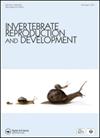Parameters of the Spondylus limbatus GB Sowerby II, 1847, population in the Central-West Gulf of California, Mexico
IF 0.8
4区 生物学
Q4 REPRODUCTIVE BIOLOGY
引用次数: 0
Abstract
ABSTRACT The main Spondylus limbatus population parameters were estimated based on the analysis of individual growth and reproductive aspects of specimens collected monthly (n = 30) from January to December 2009 in the fishing area of Agua Verde, Gulf of California. The size structure determined from shell measurements was 82–167 mm and the direct reading of shell sections indicated ages of 1–14 years. The data were adjusted to the von Bertalanffy, Gompertz, logistic, Richards and Schnute (Type 1) growth models. The von Bertalanffy model provided the best fit to describe individual growth in this species (SH∞ = 142.7 mm, k = 0.47, t0 = −0.20 years). The spawning season was determined through gonadal histology, and the size and age at sexual maturity through a logistic model. Reproductive activity occurred from March to September, with spawning peaks in July and August. The size and age at sexual maturity were 10.8 mm and 2.7 years, respectively. This information provides the necessary knowledge to implement management measures in the area. We recommend independent studies to establish management measures for each fishing area.limbatus Spondylus GB Sowerby II, 1847年,墨西哥加利福尼亚湾中西部种群的参数
摘要通过对2009年1 - 12月在美国加州湾阿瓜佛得岛渔区每月采集的30只边缘脊柱鱼的个体生长和繁殖情况进行分析,估计了边缘脊柱鱼种群的主要参数。壳的尺寸结构为82 ~ 167 mm,壳截面的直接读数显示年龄为1 ~ 14年。数据调整为von Bertalanffy、Gompertz、logistic、Richards和Schnute (Type 1)增长模型。von Bertalanffy模型最适合描述该物种的个体生长(SH∞= 142.7 mm, k = 0.47, t0 =−0.20年)。通过性腺组织学确定产卵季节,通过logistic模型确定性成熟时的大小和年龄。繁殖活动发生在3 - 9月,产卵高峰在7 - 8月。体长10.8 mm,性成熟年龄2.7岁。这些信息为在该地区实施管理措施提供了必要的知识。我们建议进行独立研究,为每个渔区制定管理措施。
本文章由计算机程序翻译,如有差异,请以英文原文为准。
求助全文
约1分钟内获得全文
求助全文
来源期刊
CiteScore
1.90
自引率
0.00%
发文量
21
审稿时长
>12 weeks
期刊介绍:
Invertebrate Reproduction & Development ( IRD) presents original research on the reproductive and developmental biology of the Invertebrata, both embryonic and postembryonic. IRD welcomes papers reporting significant results obtained using new techniques. Encouraged topic areas include: aquaculture, physiology, biochemistry, functional morphology, phylogeny, behavioural and regulatory mechanisms, including genetic, endocrine and molecular studies. Papers containing qualitative descriptions of reproductive cycles and gametogenesis will not be considered. IRD is published in association with the International Society of Invertebrate Reproduction and Development.

 求助内容:
求助内容: 应助结果提醒方式:
应助结果提醒方式:


